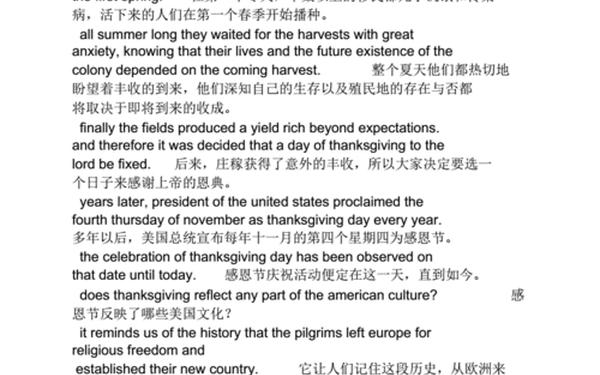Origin of Thanksgiving: A Brief Introduction in English
Thanksgiving, a cherished holiday in the United States and Canada, traces its roots to a historic harvest celebration in 1621 between English Pilgrims and Native Americans. Here’s a concise overview of its origins:
1. The Pilgrims’ Journey and Hardships
In 1620, a group of English settlers known as the Pilgrims sailed to North America aboard the Mayflower to escape religious persecution. They landed at Plymouth Rock (present-day Massachusetts) but faced a devastating first winter, with nearly half of the original 102 colonists perishing due to harsh conditions and disease.
2. The First Thanksgiving Feast (1621)
With the help of the Wampanoag tribe, particularly Squanto, who taught them farming techniques, the Pilgrims reaped a successful harvest in 1621. To celebrate, Governor William Bradford organized a three-day feast, inviting approximately 90 Wampanoag members. The menu included venison, wildfowl, corn, and other locally sourced foods—though not modern staples like pumpkin pie or cranberry sauce, which were introduced later. This event symbolized cooperation and gratitude, though it was not yet an annual tradition.
3. Evolution into a National Holiday
4. Cultural Significance
Modern Thanksgiving emphasizes family reunions, gratitude, and traditional meals (e.g., roast turkey, stuffing, and pumpkin pie). It also sparks reflection on the complex history between European settlers and Native Americans, acknowledging both the celebratory origins and the subsequent conflicts.
Key Quote from Historical Records
Edward Winslow, a Pilgrim leader, wrote: “Our harvest being gotten in, our governor sent four men on fowling, that so we might after a special manner rejoice together... they [the Wampanoag] went out and killed five Deer, which they brought to the Plantation and bestowed on our Governor.”
This blend of historical gratitude and cultural adaptation has made Thanksgiving a enduring symbol of harvest, community, and reflection.


